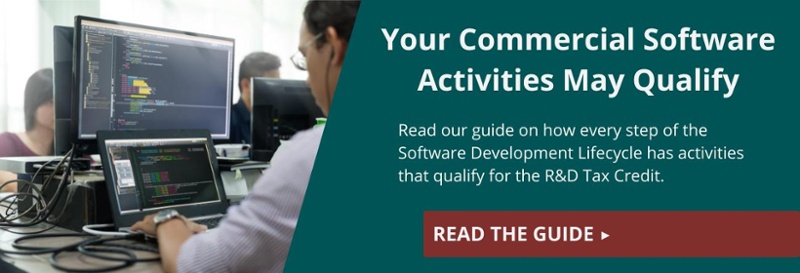
Software companies regularly participate in research and development activities to enhance and/or develop new software. With the software industry continuing to change at an accelerating rate, companies must continuously improve, enhance, and innovate to stay competitive. The R&D tax credit provides an incentive for companies to continue innovating by offering a lucrative tax credit for qualifying research and development activities.
Software Development Lifecycle
Throughout the software development lifecycle, there are many areas where qualified R&D activities occur. Companies planning to claim the benefits of the R&D tax credit should be mindful of capturing the hours spent on qualifying activities in order to ensure they don’t leave money on the table. One of our previous blog posts highlighted all seven phases of the software development lifecycle in order to show the range of qualifying activities. This blog will focus in on activities within phase five: testing and integration.
Testing and Integration
This phase involves system testing and integration – of both software programs and processes. This testing is typically conducted by a quality assurance (QA) professionals as well as end-users to determine if the proposed design meets the business goals.
Quality assurance testing happens after programmers have completed some level of unit testing. A QA professional will follow up with additional tests to check for errors, bugs, usability, interoperability and stress testing. Verification and validation will also be completed by the end users to ensure the programs, overall system and operating procedures meet their real-world production needs. Specific activities could include:
- Developing a testing plan, strategy, and process for implementation
- Designing test cases
- Building test cases
- Executing test cases
- Documenting and analyzing results
- Correcting any identified defects
- Repeating the process until all defects are eliminated
Depending on the results, all of this testing could result in the need for additional research and development to resolve any identified defects. The testing process then continues until the last issues are resolved. While this requires additional investment, it also means more activities that qualifies for the R&D tax credit and results in a successful system implementation.
The Four-Part Test
Once you’ve identified potential qualifying activities, run them through the four-part test to verify. All parts of the test must be met in order to qualify. The four parts of the test are:
- Permitted Purpose. This is the activity intended to make or improve either a product or process that results in improved function, performance, reliability, quality or cost efficiency.
- Technical Uncertainty. This is the activity intended to eliminate technical uncertainty when developing or improving a product or process related to methodology, design, techniques, formulas or inventions.
- Process of Experimentation. This is the activity that includes a process of experimentation to eliminate or resolve technical uncertainty. During the process, various alternatives and approaches are evaluated by modeling, simulation, trial and error, prototyping and other methods.
- Technological in Nature. The process of experimentation must rely on the hard sciences (engineering, physics, biology, chemistry, computer science).
Get Expert Help
Applying for the R&D Tax Credit can be a complex process. Talk with a tax professional to ensure your company’s activities qualify and you have the necessary documentation to file your claims.





